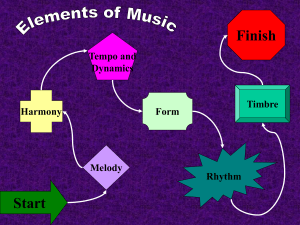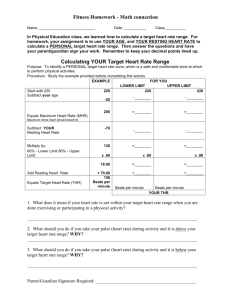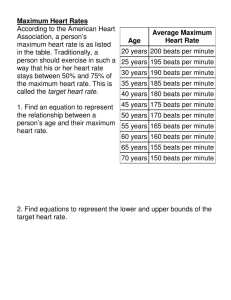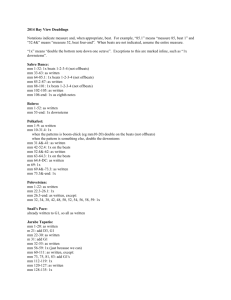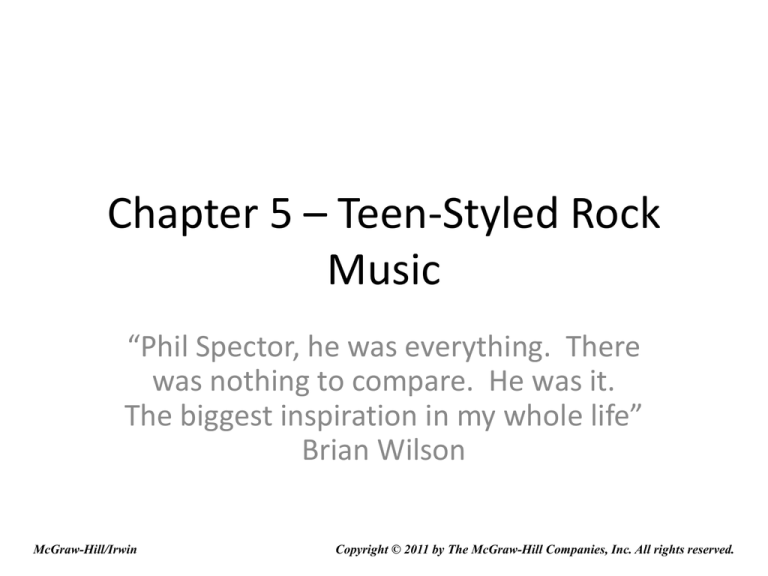
Chapter 5 – Teen-Styled Rock
Music
“Phil Spector, he was everything. There
was nothing to compare. He was it.
The biggest inspiration in my whole life”
Brian Wilson
McGraw-Hill/Irwin
Copyright © 2011 by The McGraw-Hill Companies, Inc. All rights reserved.
Performers
Late 1950s/early 60s performers whose careers
were ended (temporarily, or permanently)
Deaths: Buddy Holly, the big Bopper, Ritchie
Valens, Eddie Cochran
Serious injuries: Carl Perkins, Gene Vincent
Career quitting/banning: Little Richard, Jerry Lee
Lewis
Army service: Elvis Presley
Trials and prison in early 60s: Chuck Berry
Some performers changed style to fit pop trend
5-2
The Payola Scandal
Songwriters paid for work
Sheet music sales
Money for recordings of songs
Public performance fees collected from venues by
American Society of Composers, Authors, and
Publishers (ASCAP) and Broadcast Music
Incorporated (BMI), paid to songwriter
members
A Special Committee on Legislative Oversight asked by
ASCAP to investigate payola practices
Result, many small record companies and some disc jockeys
out of business
5-3
Notable Figures
Alan Freed (1921-1965), disc jockey, concert promoter
Fought racism by playing R&B on radio and TV
Found guilty of payola, lost TV show, career, and died
Dick Clark (born in 1929), American Bandstand TV show
host
Investigated for payola, but attorneys showed that
promotions included recordings with no financial
interest for Clark
Sold interests in recordings and continued TV show for
decades
5-4
Teen Idol Pop
Pat Boone (born in 1934), pop singer who covered
some blues and r&b songs to appeal to large,
multi-racial audiences
Teen idol singers chosen for wholesome visual
appeal more than voices, often lip-synced to
recordings for performances in movies or on TV
Songs about love and temporarily broken hearts
prevailed
5-5
Listening Guide
“Tutti-Frutti” by Little Richard (1955)
Tempo: 172 beats per minute, 4 beats per bar
Form: 12-bar blues
Features: Little Richard introduces rough vocal style with
introduction of nonsense syllables
Rhythm section includes piano using even beat subdivisions
to offset uneven divisions of basic beat, jazz-style walking
bass, and rhythmic punctuation by saxophones
Drummer plays strong backbeat
Lyrics: Little Richard brags about sex with Sue and Daisy
Charts: Pop, #17, R&B, #2 for six weeks, British hits, #29
5-6
Listening Guide
“Tutti-Frutti” by Pat Boone (1956)
Tempo: 176 beats per minute, 4 beats per bar
Form: 12-bar blues
Features: Boone tries to imitate Little Richard’s voice, but in a
smoother, less rhythmic way
Rhythm section includes piano and a backup vocal group
singing “ahs”
Uneven beat subdivisions
Backbeat present, but less obvious than in Little Richard’s
recording
Lyrics: Obvious sex (term “rocking”) avoided. Singer’s girlfriend is
Sue, but he likes Daisy
Charts: Pop, #12
5-7
Listening Guide
“Venus” by Frankie Avalon (1959)
Tempo: 114 beats per minute, 4 beats per bar
Form: 8 bar periods
Features: Full sounding orchestra and chorus
with drums
Gentle mood sung with sense of sincerity
Lyrics: Singer desperate for romance prays to the
Roman goddess for love
Charts: Pop, #1 for five weeks, British hits, #16
5-8
Brill Building Pop
Brill Building on Broadway in New York
Center for songwriting and production of teen idol pop
style recordings
Girl group sound popular
Writing teams:
Greenfield/Sedaka
Mann/Weil
Pomus/Shuman
Goffin/King
Leiber/Stoller
Barry/Greenwich
5-9
Listening Guide
“Will You Love Me tomorrow?” by the Shirelles (1960)
Tempo: 138 beats per minute, 4 beats per bar
Form: 4-bar introduction, 16-bar periods in AABAA form
Features: Even beat subdivisions
Shirley Alston’s solo backed by Shirelles
Backbeat stressed in drums
Orchestral string section plays phrase-ending fills and an
instrumental section
Lyrics: The singer is unsure if sex will lead to a lasting relationship
Charts: Pop, #1 for two weeks, #2 for four weeks, British hits, #4
5-10
Phil Spector’s Wall of Sound
Phil Spector (born in 1940), songwriter, producer, record company
owner
“Wall” created by:
overdubbing
large number of instruments including colorful
percussion such as chimes and castanets
monaural recording to avoid separation of sounds
Produced many teen idol hits, and produced Beatles’ Let it Be and
other albums by Harrison and Lennon
Sentenced to 19 years to life in prison in 2009 for the death of Lana
Clarkson
5-11
Listening Guide
“Be My Baby” by the Ronettes (1963)
Tempo: 132 beats per minute, 4 beats per bar
Form: 4-bar introduction, then 8 and 16 bar sections
Features: Lead singer backed by the Ronettes
Wall of sound background
Low strings play melody in instrumental
A short break is punctuated by percussion
Lyrics: Singer promises her undying love and affection
Charts: Pop, #2, R&B, #4, British hits, #4
5-12
Influences on the Surf Sound
Duane Eddy (born in 1938) singer, guitarist
Style known as “twangy guitar,” used vibrato
and nasel-sounding attack on bass
strings
The Ventures (first recorded in 1960)
Instrumental group influenced surf guitar and
drum sounds, adopted surf image
5-13
The Surf Sound
Dick Dale (born in 1937)
Known as the King of Surf Guitar
Used tremolo (fast repeated notes) to create effect of speed
The Beach Boys
Main writer and producer, Brian Wilson (born in 1942)
Group vocals influenced by Jazz group the Four Freshmen
Guitarist, Carl Wilson (1946-1996), influenced by Chuck Berry
Productions on Pet Sounds (1966) influenced by Phil Spector’s
Wall of Sound
5-14
Listening Guide
“Sweet Little Sixteen” by Chuck Berry (1958)
Tempo: 176 beats per minute, 4 beats per bar
Form: 2-bar introduction, then 16-bar periods each of which has an
antecedent and a consequent phrase
The first period begins with “Boston” and ends with “sweet little
sixteen”
Features: Uneven beat subdivisions
Drums keep a strong backbeat
Instruments sometimes break for vocal solos
Berry’s guitar maintains a riff pattern
Boogie-woogie piano in fifth period
Lyrics: Sixteen year old girl wants to go our and “rock and roll”
Charts: Pop, #2 for three weeks, R&B, #1 for three weeks, British hits, #16
5-15
Listening Guide
“Surfin’ U.S.A.” by the Beach Boys (1963)
Tempo: 164 beats per minute, 4 beats per bar
Form: Introduction and periods match those in Berry’s recording,
but there are fewer verses
The first period begins on “ocean” and ends with “surfin’
U.S.A.”
Features: Even beat subdivisions used most of the time
Drums accent strong backbeat
The rhythm of Berry’s guitar riff is imitated
Lyrics: The singer wishes that everyone could have fun surfing. The
beaches named parallel the cities in Berry’s song
Charts: Pop, #3, R&B, #20, British hits, #35
5-16
Listening Guide
“Good Vibrations” by the Beach Boys (1966)
Tempo: 152 beats per minute beginning and ending, but 138 beats per
minute in D section
4-beats per bar
Form: 8-bar phrases, with some extensions
ABAB with “good vibrations” in B sections
Instrumental C section
D section sustained organ chords
Features: Uneven beat subdivisions
Background thickly overdubbed
Monaural recording
Drums in A sections, tambourine on backbeats in B sections
Electro-theremin used during B sections
Lyrics: Singer is excited about a woman
Charts: Pop, #1, British hits, #1
5-17
Discussion Questions
What performers today are more pop than rock,
but are advertised as rock artists? Are any of
them, Britney Spears or Madonna, for
example, as far from being rock musicians as
Pat Boone was in the late fifties and early
sixties?
5-18

